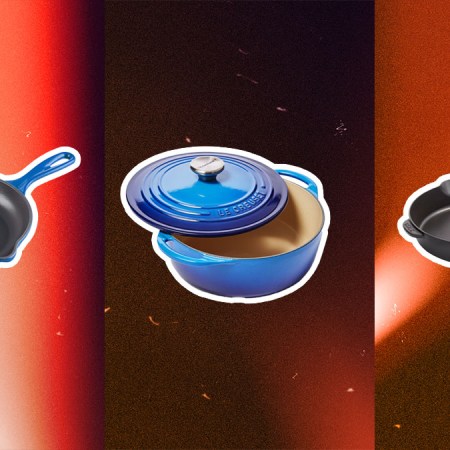This is Deep Cuts, an ongoing series in which our favorite chefs teach us how to turn oft-overlooked cuts of meat into a meal befitting a king. Enjoy.
Your compatriots here at InsideHook are never going to tell you not to eat steak. We love steak. Hell, we’ve got an entire event dedicated to it.
What we will suggest is that you occasionally expand your culinary horizons — and where your butcher’s case is concerned, that means looking past the filets, T-bones and chops to get into what we like to call the “cheap meats.”
Now to clarify, we’re not talking low quality meat. We’re talking about the unsung, oft-overlooked cuts that maybe don’t have the prestige of their pricier counterparts, but with a little knowhow, can yield a meal every bit as belly-pattin’ delicious.
And to help, we’ve enlisted a cabal of chefs from some of the country’s best restaurants to fill us in on their favorite economic cuts, how best to cook them and even what drink to pair them with.
That money you’re about to save? Put it toward dessert.
BEEF SHANK
The Chef: Ash Fulk, Culinary Director at Hill Country Hospitality, NYC/DC
Why Beef Shank? “A cross-cut beef shank is like veal osso bucco, only all grown up. I love this cut — the bone in the middle helps give it a rich, beefy flavor. I do my braise in red wine and serve it with grits, or you can include potato in the braise for a one-pot dish.”
What to Drink? “A Cider Sangria” (Brandy, Hard East Honey Cider, Domaine De Canton)
Red Wine Braised Beef Shank
Ingredients:
- 2 cross-cut beef shanks
- 1 large carrot, diced large
- 2 ribs celery, cut in one-inch lengths
- 1 white onion, diced large
- 1 leek, cleaned thoroughly and sliced in circles
- 2 Yukon Gold potatoes (optional)
- 3 bay leaves (fresh is best)
- 1/2 bunch thyme
- 1 bunch parsley (flat leaf)
- 8oz tomato paste
- chili flake
- salt
- red wine
Preparation:
Pat the beef shanks dry with a towel and season with salt. In a deep oven-proof pan, sear both shanks until golden brown. Some brown will stick to the pan — you want this, trust me. Remove beef from the pan.
Add vegetables to the pan and salt. Cook them down for about 8 minutes. Add tomato paste and cook for 4-5 minutes. Add wine (about a half bottle). Add herbs, chili flake (I do about 2 teaspoons).
Nestle the beef back in the pan with the vegetables and wine, add water or more wine to cover the beef. Bring to a boil. Cover and place in a 275-degree oven for about 4 hours or until the beef pulls away from the bone.
LAMB RIBS
The Chef: Jason Hall, Executive Chef at Legasea, NYC
Why Lamb Ribs? “Lamb ribs are a lot easier to grill for the home cook than the typical rack. They’re a lot leaner and the bones protect the meat during grilling, so they’re more forgiving. They’re thin with a good amount of fat, so they cook pretty quickly — they just need a good char on both sides and they’re done. They’re also about half the cost.”
What to Drink? “The marinade has some Spanish notes so I’d suggest pairing with a Txakolina: a slightly sparkling, very dry white wine from the Basque region. Has high acidity to cut the fat, low alcohol content for easy drinking. Best served iced cold.”
Grilled Lamb Short Ribs
Ingredients:
- 4 racks well-trimmed, meaty lamb short ribs (appx 5.5 lbs) cut in half
- 2 cups sherry vinegar
- 1/2 cup fresh lemon juice
- 1/2 cup chopped rosemary sprigs
- 6 garlic cloves, thinly sliced
- extra virgin olive oil (for brushing)
- kosher salt
- pepper
- mint
- 1 lemon
- horseradish
Preparation:
In a bowl, whisk the sherry vinegar with the lemon juice, rosemary and garlic. Pour the marinade into two large, resealable plastic bags. Add the ribs, seal the bags and turn to coat the ribs. Let the ribs marinate at room temperature for 1 hour, turning the bags halfway through.
Light your grill. Remove the ribs from the marinade. Scrape off the garlic and rosemary and pat the ribs dry with paper towels. Brush the ribs with oil and season with salt and pepper. Grill the ribs over moderately high heat, turning, until nicely charred outside and medium-rare, 12-14 minutes. Let rest for 5 minutes.
Transfer to a platter and serve with fresh chopped parsley, mint, grated lemon zest, freshly grated horseradish.
Top with olive oil and sea salt.
CHUCK ROAST
The Chef: Kevin Korman, Executive Chef at Whitebird and Whiskey Thief, Chattanooga, TN
Why Chuck Roast? “I’ve always had an appreciation for the underdog: the idea of taking something unassuming and showing that it can be great. Chuck is typically only used for ground beef because it is a muscle of the animal. It has more connective tissue, which makes it tough, but it also creates more flavor. You just have to know how to coax it out.”
What to Drink? “Because of the rich flavor of the roast, I’d recommend a heavy-bodied red such as a French Bordeaux or a California Zinfandel.”
Slow Roasted Chuck Roast with Dijon, Persillade Crumbs & Pan Sauce
Ingredients:
- 2 lb chuck roast
- 1/4 cup dijon mustard (reserve a tbsp each for sauce and crumbs)
- 1/2 cup bread crumbs
- 1 bunch parsley
- 3 garlic cloves
- kosher salt
- black pepper
Pan Sauce:
- 1/4 cup red wine
- 1 cup beef stock
- 1 shallot, minced
- 1 tbsp Dijon mustard
- 2 tbsp butter
- 1 sprig of thyme, minced
Preparation:
Season the roast with salt and pepper and sear on both sides in a hot pan (preferably a deep cast iron pan w/ a lid) with 1 tbsp of oil. Remove from the heat and brush the roast with the Dijon all over. Place the lid on and transfer to a preheated 275-degree oven and cook for 6 hours.
Meanwhile, combine the bread crumbs with one tbsp of Dijon and the garlic cloves in a food processor. Blend until the crumbs turn green. After the roast is finished cooking, brush it with Dijon one more time and top with the bread crumbs. Return to oven uncovered for 5 minutes. Remove from the pan to a cutting board. Let rest for 10 minutes and carve.
While the roast is resting, make the pan sauce. Sautee the shallots in the roasting pan. Add one tbsp of Dijon and cook for 30 seconds. Deglaze with the red wine. Add the beef stock and reduce by half. Swirl in the butter and thyme and season with salt and pepper.
LAMB SHANK
The Chef: Jess Pryles, Author, Hardcore Carnivore
Why Lamb Shanks? “Lamb shanks are incredible due to their imense amount of flavor, but they need a lot of cooking time or they’re very tough. However, they’re super easy to cook, because unlike rare beef, you can’t risk overcooking them. Paired with a tasty braising liquid, you simply cook them until the meat is tender enough to fall away from the bone. They make for incredible ragus, too.”
What to Drink? “This dish is rich and unctuous and can stand up to some lovely red wines. Pair it with a bold Tempranillo, Malbec or Cabernet Sauvignon for a perfect weekend meal.”
Balsamic Blackberry Lamb Shanks with Creamy Grits
Ingredients:
- 4 lamb shanks
- kosher salt
- 2 tbsp olive oil
- 1 onion, diced
- 2 carrots, diced
- 3 cups frozen blackberries
- 4 oz balsamic vinegar
- 6 cloves
- 6 cardamom pods (or 2 tsp ground cardamom)
- 1 cinnamon stick
- 2 thyme sprigs
- 2 cups red wine
- 2 cups chicken stock
- 1/4 cup brown sugar
- 1/4 cup honey
- 1 tbsp corn starch
- 2 tbsp butter
Preparation:
Season the lamb shanks generously with salt. Heat 1 tbsp of the olive oil in a large pot and brown the shanks over high heat. Remove and set aside.
Add the remaining oil to the pot, then the onion and carrots and cook for 4-6 minutes until softened. Add the blackberries, balsamic vinegar, cloves, cardamom, cinnamon stick, thyme sprigs, wine and stock. Bring the mixture to the boil.
Return the shanks to the pot, laying them on their sides. Cover with a lid and cook in the oven for 1 hour at 320 degrees. Uncover the pot, turn the shanks over and cook for a further 45 minutes, uncovered.
Remove the pot from the oven and ladle out some of the braising liquid through a sieve until you have 2 cups of strained liquid. Place this in a small saucepan. Turn the shanks once more in the pot, return to the oven and cook, uncovered, for a final 45 minutes, or until tender.
Add the brown sugar and honey to the strained liquid in the saucepan. Bring to a simmer and cook until reduced by at least half. Dissolve the cornstarch in 1-2 tbsp water, then add this paste and the butter to the sauce, whisking to combine (the finished sauce should have a syrupy consistency).
To make the grits, heat the milk and water to just before boiling. Stir in the grits and cook over low heat, stirring often, for about 20 minutes, or until cooked through and tender. Stir in the cream and butter and season with salt, to taste.
To serve, spoon a generous portion of grits into a bowl and top with a shank. Drizzle a few spoonfuls of sauce over the top. If you want to stretch the meat to feed more people, shred it from the bone and serve shredded portions over the grits.
PORK NECK
The Chef: Thomas Chen, Chef/Owner at Tuome, NYC
Why Pork Neck? “The pork neck is a muscled cut with a good ratio of meat and fat. Slow grilling the pork neck allows the meat to stay tender and the fat to melt. It is extremely moist and meaty after cooking through. Great for BBQ.”
What to Drink? “A refreshing beer.”
Grilled Pork Neck with Shishito Herb Sauce
Ingredients:
- 2 lbs pork neck
- 3 tbsp olive oil
- 1 tbsp fish sauce
- salt
For Sauce:
- 1 cup cilantro, finely chopped
- 1 cup parsley, finely chopped
- 1 cup dill, finely chopped
- 2 cups Shishito peppers
- 3/4 cup olive oil
- 1 teaspon finely chopped shallot
- 1 tbsp red wine vinegar
- 2 tbsp canola oil
- salt to taste
Preparation:
Combine pork neck, olive oil and fish sauce in a bowl to marinate. Set aside for at least two hours. Preheat the grill on low heat.
Grill the pork with the lid down over low heat for approximately 45 minutes, turning the meat every few minutes. When meat is almost cooked through, turn the grill to high heat to quickly sear. Let the pork rest for 15 minutes then slice and serve with shishito herb sauce (below).
For the sauce: In a large sauté pan, heat pan on high heat and add canola oil. Add shishito peppers and toss until soft for approximately 1-2 minutes. Finely chop the shishito peppers after blistered.
Mix remaining ingredients in mixing bowl and stir. Season with salt to taste.
This article was featured in the InsideHook newsletter. Sign up now.





















